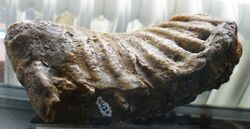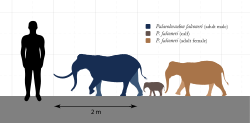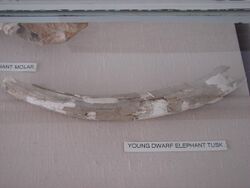Biology:Palaeoloxodon cypriotes
| Cyprus dwarf elephant | |
|---|---|

| |
| Tooth | |
| Scientific classification | |
| Domain: | Eukaryota |
| Kingdom: | Animalia |
| Phylum: | Chordata |
| Class: | Mammalia |
| Order: | Proboscidea |
| Family: | Elephantidae |
| Genus: | †Palaeoloxodon |
| Species: | †P. cypriotes
|
| Binomial name | |
| †Palaeoloxodon cypriotes (Bate, 1904)
| |
Palaeoloxodon cypriotes is an extinct species of dwarf elephant that inhabited the island of Cyprus during the Late Pleistocene. Remains comprise 44 molars, found in the north of the island, seven molars discovered in the south-east, a single measurable femur and a single tusk among very sparse additional bone and tusk fragments. The molars support derivation from the large straight-tusked elephant (Palaeoloxodon antiquus). The species is presumably derived from the older, larger P. xylophagou from the late Middle Pleistocene[1] which reached the island presumably during a Pleistocene glacial maximum when low sea levels allowed a low probability sea crossing[2] between Cyprus and Asia Minor.[3][2] During subsequent periods of isolation the population adapted within the evolutionary mechanisms of insular dwarfism, which the available sequence of molar fossils confirms to a certain extent.[4] The fully developed Palaeoloxodon cypriotes weighed not more than 200 kg (440 lb) and had a height of around 1 m (3.28 ft). The species became extinct around 12,000 years ago, around the time humans first colonised Cyprus.
Chronology
The Cyprus dwarf elephant is known from fossils dating from the early Late Pleistocene to earliest Holocene, approximately 11,000 BC. It is suggested that P. cypriotes is descended from Palaeoloxodon xylophagou, a species which is known from a partial skull collected near the village of Xylofagou in SE Cyprus dating to the late Middle Pleistocene (MIS 7, 243-191,000 years ago),[5] which is around 3.5 times larger than P. cypriotes, but still only around 7% the size of its mainland ancestor.[2] Both species are considered to have descended from the very large Palaeoloxodon antiquus (straight-tusked elephant) of mainland Europe and the Western Asia. It is likely that they arrived in Cyprus by swimming the distance between the Karpas Peninsula and southeastern Anatolia during an episode of low sea level, which even considering additional exposed land area is a minimum of 60 kilometers, further than the known swimming distance record for elephants (48 kilometers).[5] The youngest remains of P. cypriotes date to around 12,000 years before present.[5]
Description
Palaeoloxodon cypriotes was around 1 metre (3.3 ft) tall, amongst the smallest known for dwarf elephants alongside the Sicillian Palaeoloxodon falconeri.[5] The estimated body weight of P. cypriotes is only 200 kilograms (440 lb), a weight reduction of 98% from its ancestors which weighed about 10 tonnes. Their molars however were about 40% of the size of the mainland straight-tusked elephants' molars (with the teeth around the size of the milk molars of P. antiquus), which retained the same length-width ratio, but with reduced lamellae counts, with only 11 lamellae in the third molar as opposed to 18 in mainland P. antiquus.[6] The size reduction was the result of insular dwarfism, which is likely the result of the reduction in available food, predation and competition.[7]
Paleoecology
Cyprus exhibited a depauperate fauna during the Late Pleistocene, with the only other large mammal species being the Cyprus dwarf hippopotamus, with the only other terrestrial mammal species being the Cypriot mouse (which is still extant), and a species of genet (Genetta plesictoides).[7]
Excavations
The first recorded find was by Dorothea Bate in a cave in the Kyrenia hills of Cyprus in 1902, described in a paper for the Royal Society in 1903[8] and in a later paper for Philosophical Transactions of the Royal Society of London in 1905.[9] The species is also known under its synonym Elephas cypriotes.[10] Finds of whole or partial skeletons of this elephant are very rare, being heavily outnumbered by the Cyprus dwarf hippopotamus.[7]
Notes
- ↑ Athanassiou, Athanassios; Herridge, Victoria; Reese, David S.; Iliopoulos, George; Roussiakis, Socrates; Mitsopoulou, Vassiliki; Tsiolakis, Efthymios; Theodorou, George (August 2015). "Cranial evidence for the presence of a second endemic elephant species on Cyprus" (in en). Quaternary International 379: 47–57. doi:10.1016/j.quaint.2015.05.065. Bibcode: 2015QuInt.379...47A.
- ↑ 2.0 2.1 2.2 Athanassiou, Athanassios; van der Geer, Alexandra A.E.; Lyras, George A. (August 2019). "Pleistocene insular Proboscidea of the Eastern Mediterranean: A review and update" (in en). Quaternary Science Reviews 218: 306–321. doi:10.1016/j.quascirev.2019.06.028. Bibcode: 2019QSRv..218..306A.
- ↑ "Palaeloxodon cypriotes, the dwarf elephant of Cyprus: Size and scaling comparisons with P. falconeri (Sicily-Malta) and mainland P. antiquus (PDF Download Available)". https://www.researchgate.net/publication/237394736.
- ↑ "Dwarf Elephants - Planet Earth Online - So the smaller teeth are actually the teeth of younger elephants". thenakedscientists. 6 March 2012. https://www.thenakedscientists.com/articles/interviews/dwarf-elephants-planet-earth-online.
- ↑ 5.0 5.1 5.2 5.3 Athanassiou, Athanassios; Herridge, Victoria; Reese, David S.; Iliopoulos, George; Roussiakis, Socrates; Mitsopoulou, Vassiliki; Tsiolakis, Efthymios; Theodorou, George (August 2015). "Cranial evidence for the presence of a second endemic elephant species on Cyprus" (in en). Quaternary International 379: 47–57. doi:10.1016/j.quaint.2015.05.065. Bibcode: 2015QuInt.379...47A. https://linkinghub.elsevier.com/retrieve/pii/S1040618215005856.
- ↑ P. Davies, A.M. Lister (2001) Palaeoloxodon cypriotes, the dwarf elephant of Cyprus: size and scaling comparisons with P. falconeri (Sicily-Malta) and mainland P. antiquus
- ↑ 7.0 7.1 7.2 Athanassiou, Athanassios; van der Geer, Alexandra A.E.; Lyras, George A. (August 2019). "Pleistocene insular Proboscidea of the Eastern Mediterranean: A review and update" (in en). Quaternary Science Reviews 218: 306–321. doi:10.1016/j.quascirev.2019.06.028. Bibcode: 2019QSRv..218..306A. https://linkinghub.elsevier.com/retrieve/pii/S0277379119300848.
- ↑ Bate, D. M. A.: "Preliminary Note on the Discovery of a Pygmy Elephant in the Pleistocene of Cyprus" in Proceedings of the Royal Society of London Vol. 71 (1902–1903), pp. 498–500
- ↑ "Further Note on the Remains of Elephas cypriotes from a Cave-Deposit in Cyprus" by Dorothea M. A. Bate in Philosophical Transactions of the Royal Society of London, Series B, Containing Papers of a Biological Character, Vol. 197 (1905), pp. 347–360
- ↑ Reese, David S.: Men, Saints, or Dragons? in Folklore, Vol. 87, No. 1 (1976), pp. 89–95
References
- Davies, P., & Lister, A. M., Palaeoloxodon cypriotes, the dwarf elephant of Cyprus: size and scaling comparisons with P. falconeri (Sicily-Malta) and mainland P. antiquus in Cavarretta et al., op. cit. pp. 479–480
- Masseti, M., Did endemic dwarf elephants survive on Mediterranean islands up to protohistorical times? in Cavarretta, Gioia, Mussi & Palombo, La terra degli Elefanti, The World of Elephants (Rome, 2001) pp. 402–406
- Palombo, M. R., Endemic elephants of the Mediterranean Islands: knowledge, problems and perspectives in Cavarretta et al., op. cit.
- Simmons, Alan H. (1999). Faunal extinction in an island society: pygmy hippopotamus hunters of Cyprus. Interdisciplinary Contributions to Archaeology. Kluwer Academic/Plenum Publishers. pp. 382. doi:10.1007/b109876. ISBN 978-0-306-46088-3. OCLC 41712246. http://google.com/books?id=hCwYwyEBXEAC&printsec=frontcover.
External links
Wikidata ☰ Q23764987 entry
 |



